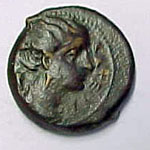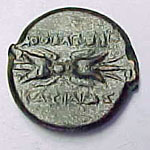The cities were busy throughout most of their history quarreling among themselves. In the west the Carthaginians set about bringing all the Phoenician cities under their control; in the east the larger cities subdued the smaller ones, with Syracuse coming out on top. Cities changed allies, governments or populations overnight; in the city of Zancle, for example, the city was taken by troops from Rhegium; they settled a number of Messenians from the Peloponnesos there, renaming the city Messana. The Carthaginians destroyed the town in 397/6 BC; the Syracusans rebuilt it under their strict control. In the 280s group of Campanian mercenaries, the Mamertini, seized it by treachery, and when the Syracusans quite reasonably tried to oust them they appealed, first to Carthage, then to Rome. This helped to trigger the First Punic War.
The major Greek settlement on Sicily was the city of Syracuse. Settled by colonists from Corinth, it worked its way up to become the dominant Greek city, largely through its resistance to Carthaginian ambitions. Under Agathokles the Syracusans threatened Carthage itself. Under Hieron II, whose reign was one of the longest in Greek history (275-215 BC), the Syracusans were firm allies of Rome. Under his successor the alliance was broken; the Romans used this as a reason to annex not only Syracuse, but the rest of Sicily as well. Sicily remained under Roman, then Byzantine, rule until the Muslims conquered it.
The coinage of Sicily is generally regarded as the most artistic in all of the Greek world. Certainly the dekadrachms of Syracuse are spectacular and magnificent; but those are but the most notable of a vast array of issues. Among the most famous issues are: a dekadrachm of Akragas, with a vigorous quadriga and two eagles on a hare, issued to commemorate the Olympic victory of Exainetos of Akragas in 412 BC: tetradrachms of Himera with the nymph Himera sacrificing at an altar; tetradrachms of Leontini, with a head of Apollo and the head of a roaring lion; tetradrachms of Messana with a leaping hare; tetradrachms of Naxos featuring Silenos squatting, drinking form a kantharos; tetradrachms of Selinos, with the river-god Silenos sacrificing at an altar; and, of course, Syracuse itself, with a variety of tetradrachms featuring the head of the nymph Aretheusa and quadrigas, fast or slow, or the tetradrachm of Agathokles with a charming Nike setting up a trophy, or the silver coins with portraits of Hieron and his wife Philistis.
Carthaginian issues, the so-called Siculo-Punic issues minted mainly at Panormos, are less varied but still artistic, usually featuring the head of Kore (Persephone or Tanit) and a galloping quadriga.
The coinage of Sicily after the Roman takeover is by comparison much less interesting, consisting entirely of bronzes of generally indifferent workmanship. These issues continued in production, in decreasing quantities, until some time around the beginning of the first century BC. Thereafter a few bronze coins were struck in the names of various magistrates under Augustus
-----------------------------------------------------------------------------------------------------------------------------------------------------------------
Sicily, Syracuse. Hiketas. 288-272 BC. Æ 17mm (9.65 gm). Laureate head of Zeus Hellanios right / Eagle standing left on thunderbolt. Calciati II pg.307, 159; SNG ANS 1212 VF, dark black
-----------------------------------------------------------------------------------------------------------------------------------------------------------------
Sicily, MENAINON, after 210 BC, AE tetras, S 1129, Obv: Veiled bust of Demeter r., wreathed with corn, Rev: Two torches crossed, MENA to the l., and INÙN to the r., III below, slightly porous dark patina VF+.
-----------------------------------------------------------------------------------------------------------------------------------------------------------------
Syracuse, Sicily, Æ17, (3.29g) 317-310 BC, Head of Persephone left, wearing earring and necklace. / L Bull butting left. Delta/club above. BMC 629. Near EF, green patina.
-----------------------------------------------------------------------------------------------------------------------------------------------------------------
Sicily. Syracuse, 344-336 B.C., Æ trias, (6.43g), Head of Athena wearing Corinthian style helmet. / Hippocamp left, with curled wing. S1193var. VF, dark brown patina.
-----------------------------------------------------------------------------------------------------------------------------------------------------------------

